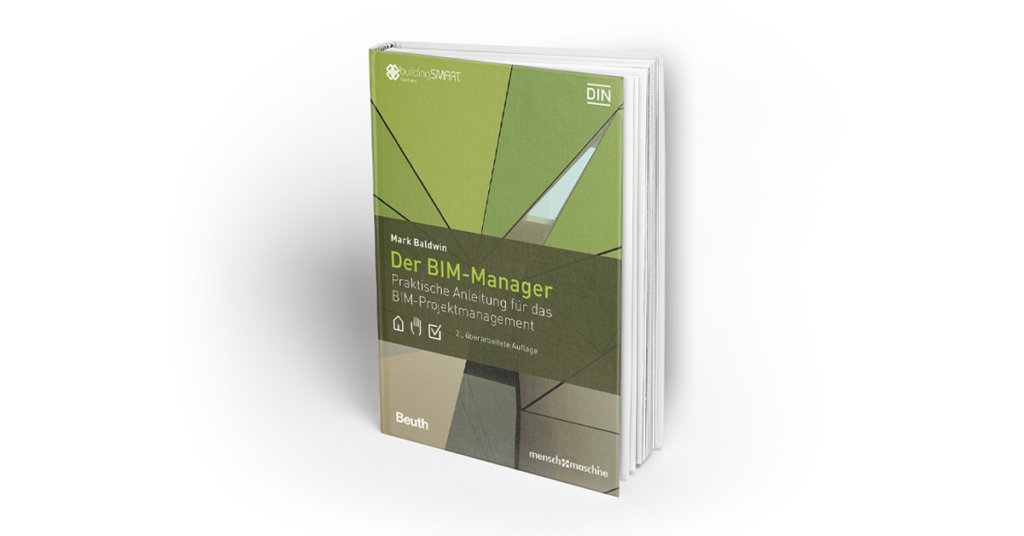
Posted by Tim Westphal
How the BIM Manager is changing the construction industry
Exclusive details about BIM expert Mark Baldwin and his book
Mark Baldwin, author of the bestseller “The BIM Manager”, is an architect and worked for many years in Australia as well as in the Middle East, especially in Dubai. He was never a stranger to BIM and digital planning, having worked with digital planning solutions and on digitized processes even before the economic crisis. The expertise he has acquired over the years is the basis of his current role as managing director for the company Digital Insights GmbH in Switzerland. He is also the author of a successful technical book on the subject entitled “The BIM Manager: Practical Guide to BIM Project Management“. Tim Westphal spoke to him for us about his book and his intention – coinciding with the release of the English edition of the bestseller. Other language editions, including Japanese and Spanish, are to follow in the coming months.
Mark, how did you get into digital building processes?

I am a graduate architect. When I worked for my first company in Australia, digital planning was already a very important topic. The office was an early adopter of BIM. I then went to Dubai for various construction projects and later moved to a general contractor. With the economic crisis in 2008, cost-effective, efficient and digital processes and BIM got a noticeable boost that made BIM a huge topic in my job. Our BIM pilot project was the Abu Dhabi Financial Center, a construction project with over $1 billion in construction. It was followed by other projects of a similar size.
How long were you in the Middle East?
In total, I was in Dubai for less than 4 years, but it felt like ten years – especially in terms of learning. My work here in Switzerland then no longer included conventional planning tasks, but only BIM processes. Before that, I worked as a project architect and used BIM as a tool. Now BIM became my work, my focus. My job at Digital Insights is to support companies in their digitalization. We accompany planning offices, construction companies, building owners and many others on this path.
Why did you decide to write a book about BIM Manager?
There are recurring, simple questions that I wanted to answer. All the knowledge I’ve acquired should come together in one book. There is still so much confusion. Architects and planners or the building owners wonder: who is the BIM manager? And what does he actually do? In addition, BIM is a method for structured work. So you don’t necessarily have to “throw everything overboard” that you did before – if you are already working in a structured way. And I know from my project experience how BIM works in many countries. I want to show what the tried and tested, the real way looks like in digital planning. The structures and processes involved are only slowly being defined. In 2015, for example, there were few AIA (client information requirements) or BAP (BIM execution plan) copies, that came later. My goal is to show the method in use.

The book is doing well? The publisher is now marketing several language versions.
Currently there is an English and a German edition. It is to follow a Japanese, a Spanish and possibly still a French and Italian version. There are many good books on the subject of BIM on the English and German-speaking markets. But especially in the German-speaking world, we have only a superficial or very academic view of the subject. In the English-speaking world, on the other hand, you will find specialist literature with a predominantly technical focus. The English-language edition is identical to the German one. Simply because I wrote it in English. We have developed local partnerships for the other language editions. In each case, the case studies are developed with authors who know the regional market well. In addition, other local adaptations run throughout the book. Between the superficiality on one side and the technical depth on the other, I wanted to move and mediate.
What kind of readers do you want to appeal to?
I want my book to be readable by everyone. That’s important to me. It picks up interested beginners as well as accomplished architects who are already in the office as BIM managers. And above all, I reach those who want to introduce BIM seriously. Of course, I also see that in a few years, such guidance will look different than it does now in my book.
What do you think will be different about a BIM guide in the future than it is today?
That’s a question I’d like to leave open. The focus for the book is to present the current state in a clear and straightforward way. We show the proven paths that have been successfully walked through countless projects and that any entrepreneur can implement today. However, there are certain signs of where the journey is headed.
What topics are you focusing on?
The book is divided into three topics. The first subsection is introduction and methodology. For example, I introduce the ISO 19650 series of standards and other international standards. In the second part follows the implementation in a company. So what does the change management associated with BIM mean for an office? And what do the changed planning procedures and new processes look like? In the third and final part, we show and explain all of this using various real projects.
BIM is, after all, lived differently in different countries. Do the language issues differ in the respective markets?
It is clearly going in the direction of simplifying digital processes. We need operable applications that can make our work easier. This is where topics such as artificial intelligence and machine learning come into play, as well as Internet of Things, Big Data, data analytics and generative design.
How important are BIM and digital design processes?
I wouldn’t say it’s important or urgent. BIM is now arriving at many companies. I think it is rather important that it is now also demanded. Take the smartphone, for example. That just came along. Nobody had missed it until then. But everyone adapted it immediately without giving it much thought. In terms of BIM, that means:
I’m not interested in missionary persuasion. I don’t want to convert anyone to BIM. Rather, I’m driven by questions about how we can make the best use of digital planning. In other words, what opportunities we see in it, how digitization can be mapped in other processes, and how we can make planning and building easier.
The big theme above all this is digitization. This is an organic development that will be with us for some time to come. I also show that in Chapter 10 of my book.
How important will planner tools like Plan.One be in the future?
For me, planning and building at the moment primarily means process management. But innovation management is a huge component for which I need good data and information. To manage that, you don’t have to keep reinventing the wheel. Rather, product data must be structured and coordinated – separate from geometry. Keyword: Product Data Templateor buildingSMART Data Dictionary. So a database solution like the one at Plan.One can provide important building product information in a structured, coordinated and standardized way. And thus make it usable for the architect and his planning.
.

Tim Westphal
Author and industry expert, specialized in architectural journalism on topics in need of explanation and complex building stories.


